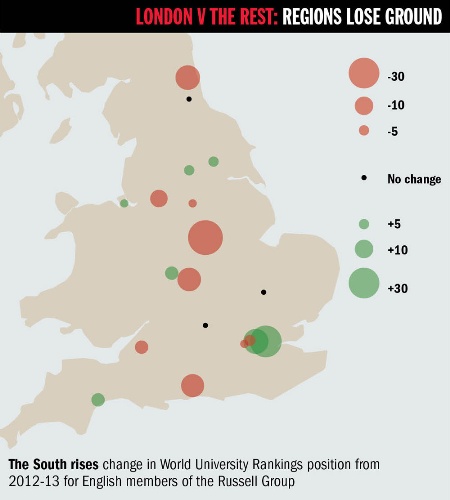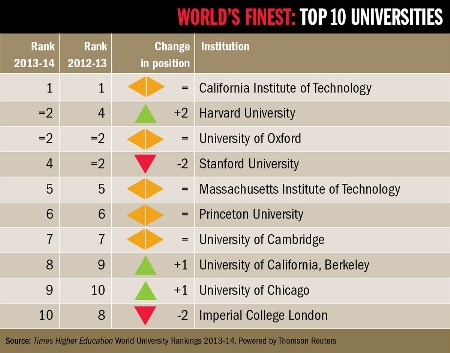Source: Getty
The megalopolis multiplier effect: there are fears that London’s powerful pull for leading researchers may be difficult to counteract
View the THE World University Rankings 2013-2014 top 400
While universities in London go from strength to strength, power may be draining from the UK regions, analysis of the Times Higher Education World University Rankings 2013-2014 suggests.
The UK has maintained its global position, with 14 institutions climbing, 14 falling and three static in the top 200, but the picture masks considerable changes on geographical lines.
Universities within London, Oxford and Cambridge – the “golden triangle” – have risen by six places on average, compared with a fall of two places among institutions in the rest of the country.
As the universities of Oxford and Cambridge maintain their 2012-13 positions (joint second and seventh, respectively), the London School of Economics climbs seven places to 32nd and King’s College London jumps from 57th to 38th. Two other institutions in the capital gain ground: Royal Holloway, University of London climbs from 119th to 102nd, and Queen Mary, University of London rises from joint 145th to joint 114th. Bucking the trend are Imperial College London (down two places to 10th) and University College London (which drops four places to 21st).
Meanwhile, losing ground are the universities of Edinburgh (39th, down from 32nd), Manchester (58th from 49th), Bristol (79th from 74th), Sheffield (joint 112th from joint 110th) and St Andrews (joint 117th from 108th).
Further down the table, the universities of Sussex, Warwick, Southampton, Aberdeen, Reading and Newcastle all fall by 10 places or more. The University of Nottingham has dropped the most, falling 37 places to joint 157th.
The results mean that London alone boasts six top 200 players, more than Japan, the world’s third-largest economy.
Jeremy Kilburn, vice-principal of Queen Mary, attributed his institution’s rise to its growing research profile, but he added that this was helped by London’s many advantages, including the capital’s high employability and rich culture.
“We’ve probably benefited from the spotlight on Stratford from the Olympics and a general sense that the East End is a ‘happening’ part of London – plugged into Tech City,” he told THE.

Power of inequality
The good news for London is dampened by concerns that the rankings performance may be reflecting growing economic inequality across the country.
Shabana Mahmood, shadow minister for universities and science, said that the government needed to do more to help the regions compete.
“Universities can be powerhouses of growth and are often catalysts for innovation, driving skills across the UK. But they need a government that stands up for them and the communities they are based in,” she said.
Sally Hunt, general secretary of the University and College Union, said that the UK had done well to hold its position on the global stage but warned: “We need to be careful not to widen the gap between North and South – which the rankings suggest is happening.”
Kieron Flanagan, lecturer in science and technology policy at the University of Manchester, said that London’s cluster of research-intensive universities provided a pull for leading researchers that was difficult to counteract.
“Even if cities such as Manchester are doing more and getting stronger, they are being so outpaced by London” because of its multiple research-intensives, the Francis Crick Institute and its number of government-backed technology and innovation “catapults”, he said.
As a result, “they will find it ever harder to compete”, he added.
Dr Flanagan contrasted the UK with countries with more “geographically aware” higher education and research policies, such as the US, where national schemes exist to fund states less favoured by conventional routes. “I can’t think of anywhere that’s as blind to geography as the UK,” he said.
However, he also cautioned against overinterpreting the results, given that the universities of York, Glasgow, Lancaster and Leicester have bucked the regional trend, with the last in the list climbing 35 places.
Worldwide, the US continues to top the rankings, boasting 77 top 200 institutions including the world number one, the California Institute of Technology (maintaining this status for the third year in a row).
However, the rankings also show a continued shift in power from West to East, with universities in China, South Korea, Singapore and Japan making gains as the top universities in continental Europe fall.
THE bases the rankings on 13 performance indicators that examine universities’ strengths in teaching, research, knowledge transfer and international outlook, compiled using data from Thomson Reuters.

View our results highlights video, presented by Mishal Husain
Listen to the World University Rankings 2013-2014 podcast
Claim your free copy of the Times Higher Education World University Rankings 2013-2014 supplement
Register to continue
Why register?
- Registration is free and only takes a moment
- Once registered, you can read 3 articles a month
- Sign up for our newsletter
Subscribe
Or subscribe for unlimited access to:
- Unlimited access to news, views, insights & reviews
- Digital editions
- Digital access to THE’s university and college rankings analysis
Already registered or a current subscriber?




